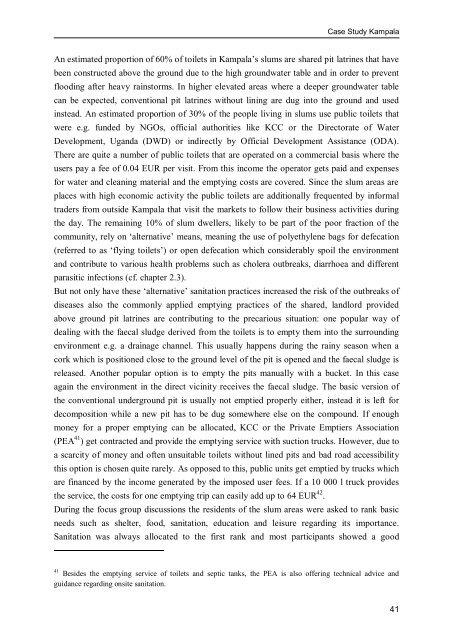Economic Effects of Sustainable Sanitation - SuSanA
Economic Effects of Sustainable Sanitation - SuSanA
Economic Effects of Sustainable Sanitation - SuSanA
You also want an ePaper? Increase the reach of your titles
YUMPU automatically turns print PDFs into web optimized ePapers that Google loves.
Case Study Kampala<br />
An estimated proportion <strong>of</strong> 60% <strong>of</strong> toilets in Kampala‘s slums are shared pit latrines that have<br />
been constructed above the ground due to the high groundwater table and in order to prevent<br />
flooding after heavy rainstorms. In higher elevated areas where a deeper groundwater table<br />
can be expected, conventional pit latrines without lining are dug into the ground and used<br />
instead. An estimated proportion <strong>of</strong> 30% <strong>of</strong> the people living in slums use public toilets that<br />
were e.g. funded by NGOs, <strong>of</strong>ficial authorities like KCC or the Directorate <strong>of</strong> Water<br />
Development, Uganda (DWD) or indirectly by Official Development Assistance (ODA).<br />
There are quite a number <strong>of</strong> public toilets that are operated on a commercial basis where the<br />
users pay a fee <strong>of</strong> 0.04 EUR per visit. From this income the operator gets paid and expenses<br />
for water and cleaning material and the emptying costs are covered. Since the slum areas are<br />
places with high economic activity the public toilets are additionally frequented by informal<br />
traders from outside Kampala that visit the markets to follow their business activities during<br />
the day. The remaining 10% <strong>of</strong> slum dwellers, likely to be part <strong>of</strong> the poor fraction <strong>of</strong> the<br />
community, rely on ‗alternative‘ means, meaning the use <strong>of</strong> polyethylene bags for defecation<br />
(referred to as ‗flying toilets‘) or open defecation which considerably spoil the environment<br />
and contribute to various health problems such as cholera outbreaks, diarrhoea and different<br />
parasitic infections (cf. chapter 2.3).<br />
But not only have these ‗alternative‘ sanitation practices increased the risk <strong>of</strong> the outbreaks <strong>of</strong><br />
diseases also the commonly applied emptying practices <strong>of</strong> the shared, landlord provided<br />
above ground pit latrines are contributing to the precarious situation: one popular way <strong>of</strong><br />
dealing with the faecal sludge derived from the toilets is to empty them into the surrounding<br />
environment e.g. a drainage channel. This usually happens during the rainy season when a<br />
cork which is positioned close to the ground level <strong>of</strong> the pit is opened and the faecal sludge is<br />
released. Another popular option is to empty the pits manually with a bucket. In this case<br />
again the environment in the direct vicinity receives the faecal sludge. The basic version <strong>of</strong><br />
the conventional underground pit is usually not emptied properly either, instead it is left for<br />
decomposition while a new pit has to be dug somewhere else on the compound. If enough<br />
money for a proper emptying can be allocated, KCC or the Private Emptiers Association<br />
(PEA 41 ) get contracted and provide the emptying service with suction trucks. However, due to<br />
a scarcity <strong>of</strong> money and <strong>of</strong>ten unsuitable toilets without lined pits and bad road accessibility<br />
this option is chosen quite rarely. As opposed to this, public units get emptied by trucks which<br />
are financed by the income generated by the imposed user fees. If a 10 000 l truck provides<br />
the service, the costs for one emptying trip can easily add up to 64 EUR 42 .<br />
During the focus group discussions the residents <strong>of</strong> the slum areas were asked to rank basic<br />
needs such as shelter, food, sanitation, education and leisure regarding its importance.<br />
<strong>Sanitation</strong> was always allocated to the first rank and most participants showed a good<br />
41 Besides the emptying service <strong>of</strong> toilets and septic tanks, the PEA is also <strong>of</strong>fering technical advice and<br />
guidance regarding onsite sanitation.<br />
41

















